Mackie PPM1012 Handleiding
Bekijk gratis de handleiding van Mackie PPM1012 (22 pagina’s), behorend tot de categorie Receiver. Deze gids werd als nuttig beoordeeld door 15 mensen en kreeg gemiddeld 4.3 sterren uit 8 reviews. Heb je een vraag over Mackie PPM1012 of wil je andere gebruikers van dit product iets vragen? Stel een vraag
Pagina 1/22

PPM1012
O W N E R ’ S M A N U A L
12-Channel, 2 x 800 W Professional Powered Mixer
80Hz
LOW
MIC 1MIC 2MIC 3MIC 4MIC 5MIC 6MIC 7MIC 8
INPUT
(BAL/UNBAL) (BAL/UNBAL) (BAL/UNBAL) (BAL/UNBAL) (BAL/UNBAL) (BAL/UNBAL) (BAL/UNBAL) (BAL/UNBAL)
INS ERT INS ERT INS ERT INS ERT INS ERT INS ERT INS ERT INS ERT
GAIN
U
-20
LAMP
12V 0.5A
L
R
FX SEND TAPE
OUTIN
L
MON SEND
FX RT N
(M ONO)
MID
FREQ
RL
U
GAIN
M
I
C
G
A
I
N
0 +50
- 20dB +30dB
600
1.5k150
8k100
OFF MAX
U
GAIN
M
I
C
G
A
I
N
0 +50
- 20dB +30dB
U
GAIN
M
I
C
G
A
I
N
0 +50
- 20dB +30dB
U
GAIN
M
I
C
G
A
I
N
0 +50
- 20dB +30dB
U
GAIN
M
I
C
G
A
I
N
0 +50
- 20dB +30dB
U
GAIN
M
I
C
G
A
I
N
0 +50
- 20dB +30dB
U
GAIN
M
I
C
G
A
I
N
0 +50
- 20dB +30dB
U
GAIN
M
I
C
G
A
I
N
0 +50
- 20dB +30dB
1 9/10 11/122 3 4 5 6 7 8
SOLO
OL
+10
0
- 20
SOLO
OL
+10
0
- 20
1 9/10 11/12
2345678
EQ EQ
OFF MAX OFF MAX OFF MAX OFF MAX OFF MAX
12kHz
HI
LOW CUT
100 Hz
U
+15-15
U
+15-15
U
+15-15
U
+15-15
+20
12kHz
HI
80Hz
LOW
HI
MID
2.5kHz
LOW
MID
400Hz
U
+15-15
U
+15-15
U
+15-15
U
+15-15
12kHz
HI
80Hz
LOW
HI
MID
2.5kHz
LOW
MID
400Hz
GAIN
U
-20
PAN
AUX
SEND
EQ
COMP COMP COMP COMP COMP COMP
+20
1
2
L
R
(M ONO)
L
R
(M ONO)
L
R
(M ONO)
1
2
FX RT N
L
R
L
R
M
L
R
M
MON
1
MON
2
FX
1
FX
2
U
+15
OO
U
+15
OO
U
+15
OO
U
+15
OO
-15
U
+15
-15
U
+15
-15
U
+15
80Hz
LOW
MID
FREQ
RL
600
1.5k150
8k100
EQ
12kHz
HI
PAN
AUX
SEND
MON
1
MON
2
FX
1
FX
2
U
+15
OO
U
+15
OO
U
+15
OO
U
+15
OO
-15
U
+15
-15
U
+15
-15
U
+15
80Hz
LOW
MID
FREQ
RL
600
1.5k150
8k100
EQ
12kHz
HI
PAN
AUX
SEND
MON
1
MON
2
FX
1
FX
2
U
+15
OO
U
+15
OO
U
+15
OO
U
+15
OO
-15
U
+15
-15
U
+15
-15
U
+15
80Hz
LOW
MID
FREQ
RL
600
1.5k150
8k100
EQ
12kHz
HI
PAN
AUX
SEND
MON
1
MON
2
FX
1
FX
2
U
+15
OO
U
+15
OO
U
+15
OO
U
+15
OO
-15
U
+15
-15
U
+15
-15
U
+15
80Hz
LOW
MID
FREQ
RL
600
1.5k150
8k100
EQ
12kHz
HI
PAN
AUX
SEND
MON
1
MON
2
FX
1
FX
2
U
+15
OO
U
+15
OO
U
+15
OO
U
+15
OO
-15
U
+15
-15
U
+15
-15
U
+15
80Hz
LOW
MID
FREQ
RL
600
1.5k150
8k100
EQ
12kHz
HI
PAN
AUX
SEND
MON
1
MON
2
FX
1
FX
2
U
+15
OO
U
+15
OO
U
+15
OO
U
+15
OO
-15
U
+15
-15
U
+15
-15
U
+15
80Hz
LOW
MID
FREQ
RL
600
1.5k150
8k100
EQ
12kHz
HI
PAN
AUX
SEND
MON
1
MON
2
FX
1
FX
2
U
+15
OO
U
+15
OO
U
+15
OO
U
+15
OO
-15
U
+15
-15
U
+15
-15
U
+15
80Hz
LOW
MID
FREQ
RL
600
1.5k150
8k100
EQ
12kHz
HI
PAN
AUX
SEND
MON
1
MON
2
FX
1
FX
2
U
+15
OO
U
+15
OO
U
+15
OO
U
+15
OO
RL
PAN
AUX
SEND
MON
1
MON
2
FX
1
FX
2
U
+15
OO
U
+15
OO
U
+15
OO
U
+15
OO
RL
PAN
AUX
SEND
MON
1
FX
MON
2
FX
1
FX
2
U
+15
OO
U
+15
OO
U
+15
OO
U
+15
OO
-15
U
+15
-15
U
+15
-15
U
+15
1FX 2
9 1 210/ INPUT 11 12/ MAIN OUT
MAIN INSERT
T AP
DELAY
INT FX
MUT E
T AP
DELAY
INT FX
MUT E
T AP T O EDIT
01 PLAT E REVERB
02 VO CAL PLAT E
03 WARM ROOM
04 BRIGHT ROOM
13 CHORUS
14 CHORUS + REVERB
15 DOUBLER
16 TAPE SLAP
05 WARM LOUNGE
06 SMALL STAGE
07 WARM T HEAT ER
08 BRIGHT ST AGE
09 WARM HALL
10 CONCERT HALL
11 CAT HEDRAL
12 GAT ED REVERB
17 DLY 1 BRIGHT (350ms)
18 DLY 1 WARM (300ms)
19 DLY 2 BRIGHT (250ms)
20 DLY 2 WARM (200ms)
21 DLY 3 BRIGHT (175ms)
22 DLY 3 WARM (150ms)
23 CHORUS + DLY (300ms)
24 REVERB + DLY (200ms)
15
15
10
10
5
5
0
15
15
10
10
5
5
0
16K8K4K2K1K5002501256 3
HI-Z HI-Z
OL
4
6
3
10
15
7
10
20
30
0
2
U
+20
OO
TAPE IN
BREAK
MUT ES
CH 1- 12
U
+15
O
O
U
+15
O
O
TO MON
1TO MON 2
FX
1FX 1
MONO OUT
LPF
OO
MAX
75Hz
100 180
120
200Hz
0dB = 0dBu
LEVEL
SET
RUDE
SOLO
MAIN
MON 2
EQ ASSIGN
MAIN
METERS
RL
PHANTOM
POWER
MAIN EQUALIZER
MON 1 EQUALIZER
15
15
10
10
5
5
0
15
15
10
10
5
5
0
16K8K4K2K1K5002501256 3
SIG/O LSIG/O L
U
+15
OO
SEND MASTER
U
+15
OO
SEND MASTER
LOW CUT
100 Hz
LOW CUT
100 Hz
LOW CUT
100 Hz
LOW CUT
100 Hz
LOW CUT
100 Hz
LOW CUT
100 Hz
LOW CUT
100 Hz
dB
10
OO
5
5
U
dB
30
20
10
OO
40
50
5
5
U
60
SOLO
OL
+10
0
- 20
dB
30
20
10
OO
40
50
5
5
U
60
SOLO
OL
+10
0
- 20
dB
30
20
10
OO
40
50
5
5
U
60
SOLO
OL
+10
0
- 20
dB
30
20
10
OO
40
50
5
5
U
60
SOLO
OL
+10
0
- 20
dB
30
20
10
OO
40
50
5
5
U
60
SOLO
OL
+10
0
- 20
dB
30
20
10
OO
40
50
5
5
U
60
SOLO
OL
+10
0
- 20
dB
30
20
10
OO
40
50
5
5
U
60
SO LO
OL
+10
0
- 20
dB
30
20
10
OO
40
50
5
5
U
60
SO LO
OL
+10
0
- 20
dB
30
20
10
OO
40
50
5
5
U
60
SO LO
dB
30
20
10
OO
40
50
5
5
U
60
SO LO
dB
30
20
10
OO
40
50
5
5
U
60
SO LO
dB
30
20
10
OO
40
50
5
5
U
60
SO LO
dB
30
20
10
OO
40
50
5
5
U
60
dB
30
20
10
OO
40
50
5
5
U
60
FX RTN
1FX RTN 2MON 1MON 2 MAIN
FOOT S WIT CH
T IP : FX1
RING: FX2
PHONES
FX
LEVEL
2 X 800W PRO FESSIONAL POWERED MIXER
OO
MAX
30
20
40
50
60
10 10 10 10 10 10 10 10 10 10 10 10 10 10 10
(L) (R)
MON 1
MON 2
MAINS
MON 1
ST EREO
MAIN
A B
LINELINELINELINELINELINELINE
HI- Z
LINE
HI- Z
POWER AMP
LIMIT ER
A B
POWER AMP
MODE
R

PPM101
PPM1012
1. Read these instructions.
2. Keep these instructions.
3. Heed all warnings.
4. Follow all instructions.
5. Do not use this apparatus near water.
6. Clean only with a dry cloth.
7. Do not block any ventilation openings. Install in accordance with the
manufacturer’s instructions.
8. Do not install near any heat sources such as radiators, heat registers,
stoves, or other apparatus (including amplifiers) that produce heat.
9. Do not defeat the safety purpose of the polarized or grounding-type
plug. A polarized plug has two blades with one wider than the other.
A grounding-type plug has two blades and a third grounding prong.
The wide blade or the third prong are provided for your safety. If the
provided plug does not fit into your outlet, consult an electrician for
replacement of the obsolete outlet.
10.
Protect the power cord from being walked on or pinched particularly at
plugs, convenience receptacles, and the point where they exit from the
apparatus.
11.
Only use attachments/accessories specified by the manufacturer.
12.
Use only with a cart, stand, tripod, bracket, or
table specified by the manufacturer, or sold with
the apparatus. When a cart is used, use caution
when moving the cart/apparatus combination to
avoid injury from tip-over.
13.
Unplug this apparatus during lightning storms or
when unused for long periods of time.
14.
Refer all servicing to qualified service personnel. Servicing is required
when the apparatus has been damaged in any way, such as power-
supply cord or plug is damaged, liquid has been spilled or objects have
fallen into the apparatus, the apparatus has been exposed to rain or
moisture, does not operate normally, or has been dropped.
15.
Do not overload wall outlets and extension cords as this can result in a
risk of fire or electric shock.
16.
This apparatus shall not be exposed to dripping or splashing, and no
object filled with liquids, such as vases or beer glasses, shall be placed
on the apparatus.
17.
This apparatus has been designed with Class-I construction and must
be connected to a mains socket outlet with a protective earthing con-
nection (the third grounding prong).
18.
This apparatus has been equipped with an all-pole, rocker-style AC
mains power switch. This switch is located on the rear panel and
should remain readily accessible to the user.
19. NOTE: This equipment has been tested and found to comply with
the limits for a Class B digital device, pursuant to part 15 of the FCC
Rules. These limits are designed to provide reasonable protection
against harmful interference in a residential installation. This equip-
ment generates, uses, and can radiate radio frequency energy and, if
not installed and used in accordance with the instructions, may cause
harmful interference to radio communications. However, there is no
guarantee that interference will not occur in a particular installation. If
this equipment does cause harmful interference to radio or television
reception, which can be determined by turning the equipment off and
on, the user is encouraged to try to correct the interference by one or
more of the following measures:
• Reorient or relocate the receiving antenna.
• Increase the separation between the equipment and the
receiver.
• Connect the equipment into an outlet on a circuit different from
that to which the receiver is connected.
• Consult the dealer or an experienced radio/TV technician for
help.
CAUTION: Changes or modifications to this device not expressly
approved by LOUD Technologies Inc. could void the user's authority to
operate the equipment under FCC rules.
20.
This apparatus does not exceed the Class A/Class B (whichever is
applicable)
limits for radio noise emissions from digital apparatus as
set out in the radio interference regulations of the Canadian Department
of Communications.
ATTENTION — Le présent appareil numérique n’émet pas de bruits
radioélectriques dépassant las limites applicables aux appareils
numériques de class A/de class B (selon le cas) prescrites dans le
réglement sur le brouillage radioélectrique édicté par les ministere des
communications du Canada.
21.
Exposure to extremely high noise levels may cause permanent hearing
loss. Individuals vary considerably in susceptibility to noise-induced
hearing loss, but nearly everyone will lose some hearing if exposed to
sufficiently intense noise for a period of time. The U.S. Government’s
Occupational Safety and Health Administration (OSHA) has specified
the permissible noise level exposures shown in the following chart.
According to OSHA, any exposure in excess of these permissible limits
could result in some hearing loss. To ensure against potentially danger-
ous exposure to high sound pressure levels, it is recommended that all
persons exposed to equipment capable of producing high sound pres-
sure levels use hearing protectors while the equipment is in operation.
Ear plugs or protectors in the ear canals or over the ears must be worn
when operating the equipment in order to prevent permanent hearing
loss if exposure is in excess of the limits set forth here:
Important Safety Instructions
PORTABLE CART
WARNING
CAUTION AVIS
RISK OF ELECTRIC . DO NOT OPENSHOCK
RISQUE DE ELECTRIQUE. NE PAS OUVRIRCHOC
CAUTION: TO REDUCE THE RISK OF ELECTRIC SHOCK DO NOT REMOVE COVER (OR BACK)
NO USER-SERVICEABLE PARTS INSIDE. REFER SERVICING TO QUALIFIED PERSONNEL
ATTENTION: POUR EVITER LES RISQUES DE CHOC ELECTRIQUE, NE PAS ENLEVER LE COUVERCLE.
AUCUN ENTRETIEN DE PIECES INTERIEURES PAR L'USAGER.
CONFIER L'ENTRETIEN AU PERSONNEL QUALIFIE.
AVIS: POUR EVITER LES RISQUES D'INCENDIE OU D'ELECTROCUTION, N'EXPOSEZ PAS CET ARTICLE
A LA PLUIE OU A L'HUMIDITE
The lightning flash with arrowhead symbol within an equilateral triangle is
intended to alert the user to the presence of uninsulated "dangerous
voltage" within the product's enclosure, that may be of sufficient magnitude
to constitute a risk of electric shock to persons.
Le symbole éclair avec point de flèche à l'intérieur d'un triangle équilatéral
est utilisé pour alerter l'utilisateur de la présence à l'intérieur du coffret de
"voltage dangereux" non isolé d'ampleur suffisante pour constituer un risque
d'éléctrocution.
The exclamation point within an equilateral triangle is intended to alert the
user of the presence of important operating and maintenance (servicing)
instructions in the literature accompanying the appliance.
Le point d'exclamation à l'intérieur d'un triangle équilatéral est employé
pour alerter les utilisateurs de la présence d'instructions importantes pour le
fonctionnement et l'entretien (service) dans le livret d'instruction
accompagnant l'appareil.
WARNING — To reduce the risk of fire or electric shock, do not
expose this apparatus to rain or moisture.
Duration,
per day in
hours
Sound Level
dBA, Slow
Response
Typical Example
8 90 Duo in small club
6 92
4 95 Subway Train
3 97
2 100 Very loud classical music
1.5 102
1 105 Greg and Ben screaming at Troy
about deadlines
0.5 110
0.25 or less 115 Loudest parts at a rock concert

Owner’s Manual
Owner’s Manual
Part No. SW0704 Rev. E 05/09
©2009 LOUD Technologies Inc. All Rights Reserved. PDF pixels home grown and harvested in Woodinville, WA.
Don’t use guitar cords for speaker cables!
They’re not designed to handle speaker-level
signals and could overheat.
Set the levels
It’s not even necessary to hear what you’re doing to
set optimal levels. But if you’d like to: Plug headphones
into the phones output jack, then turn up the phones
knob just a little.
1. Turn on the PPM1012 by pressing the top edge
of the power switch.
2. For one channel, press the solo switch in, and
the rude solo light will turn on.
3. Play something into that input at real-world
levels.
4. Adjust that channel's gain control until the
left main meter stays around the 0 dB LED
(marked "level set").
5. Disengage the channel's solo switch.
6. Repeat steps 2 to 5 for the remaining channels.
7. In normal playing, the channel's OL LED should
only light occasionally. If it stays on for a large
portion of your performance, check that the
gain control is set correctly.
8. Turn up the channel faders to the "U" mark.
9. Slowly turn up the main level fader until you
hear the signals in your speakers.
10. If needed, apply some EQ wisely.
11. Adjust the channel faders to get the best mix.
Keep the gain controls and faders fully down on
unused channels.
Other Notes
• Only connect the powered mixer's speaker-level
outputs to passive loudspeakers.
• For optimum sonic performance, the channel
faders and main mix fader should be set near
the U (unity gain) markings.
• When shutting down, turn off any external
amplifiers first. When powering up, turn on any
external amplifiers last. This will reduce the
chance of turn-on or turn-off thumps in your
speakers.
• Save the shipping box!
Read This Page!
We realize that you must be really keen
to try out your new powered mixer. Please
read the safety instructions on page 2
and this page, and the rest can wait until
you’re ready. But please read it — you’ll be glad you did.
Setup
Make sure there is at least 6 inches of airspace behind
the powered mixer for ventilation. There are two fans
inside to cool the power amplifier section. Use the pow-
ered mixer in a nice clean environment, free from dryer
lint and dust bunnies.
Zero the controls
1. Fully turn down all the faders and controls,
except for the channel EQ, graphic EQ faders,
and pan controls, which should be centered.
2. Make sure all buttons are in the out position.
Connections
1. Make sure the AC power switch is off before
making any connections.
2. Push the linecord securely into the IEC connec-
tor on the rear panel, and plug it into a 3-prong
AC outlet that is properly configured for the
voltage of your powered mixer.
3. Plug a balanced microphone into one of the mic
XLR (3-pin) connectors. Or connect any line-
level signal (keyboard, or guitar preamp) to a
line input jack using a TS or a TRS 1/4” plug.
4. If your microphone requires phantom power,
press in the 48V phantom power button.
5. You can connect a guitar directly to line inputs
7 or 8 without need for a DI box. Press the hi-z
switch on these channels if you do.
6. The insert jacks can be used to connect an
external effects or dynamics processor into the
signal chain. See page 13 for more details.
7. Plug the speakers (4 ohms or greater) into the
speaker output jacks on the rear panel. If you
plug two speakers into a side, each speaker
must be 8 ohms or greater to maintain a 4-ohm
minimum load on the amplifier. Use at least
18 gauge speaker cable with 1/4” TS plugs. For
now, set the power amp mode switch to stereo
mains.
Product specificaties
| Merk: | Mackie |
| Categorie: | Receiver |
| Model: | PPM1012 |
Heb je hulp nodig?
Als je hulp nodig hebt met Mackie PPM1012 stel dan hieronder een vraag en andere gebruikers zullen je antwoorden
Handleiding Receiver Mackie

19 April 2023

5 November 2022

27 Oktober 2022

25 Oktober 2022

12 Oktober 2022
Handleiding Receiver
- Kinter
- Fredenstein
- Kathrein
- Palsonic
- Sunfire
- JVC
- SSL
- Ebode
- Crest Audio
- Ampeg
- Nunoo
- Fishman
- Intelix
- Phonocar
- Majestic
Nieuwste handleidingen voor Receiver
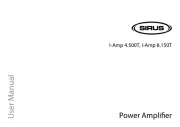
10 September 2025
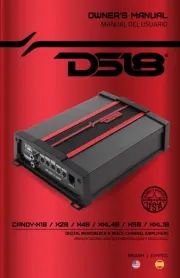
8 September 2025
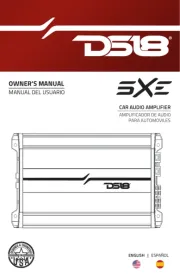
8 September 2025

8 September 2025
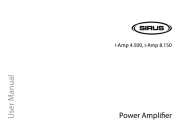
8 September 2025
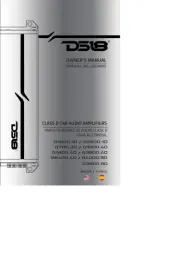
8 September 2025
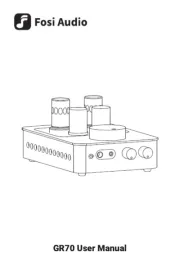
2 September 2025
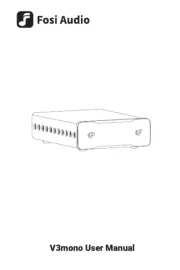
2 September 2025
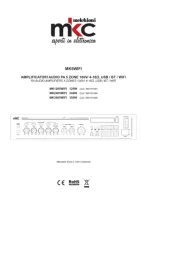
1 September 2025
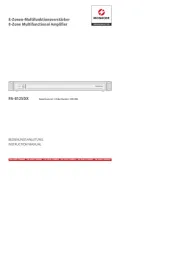
1 September 2025